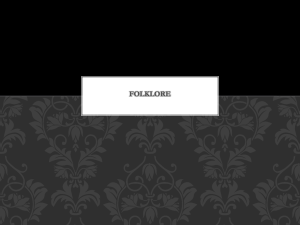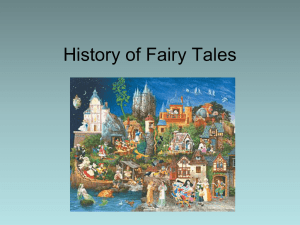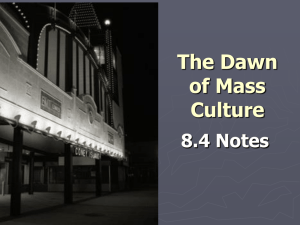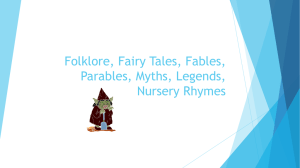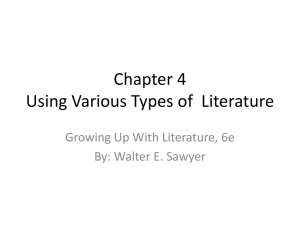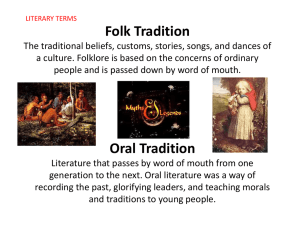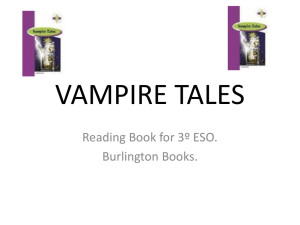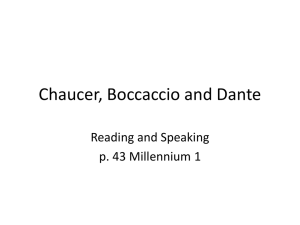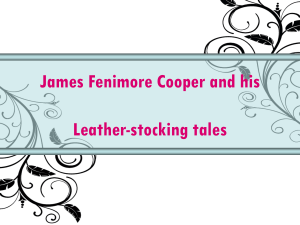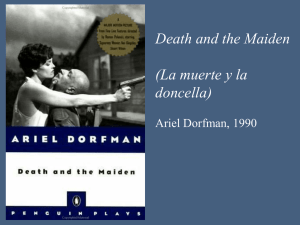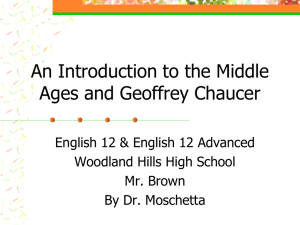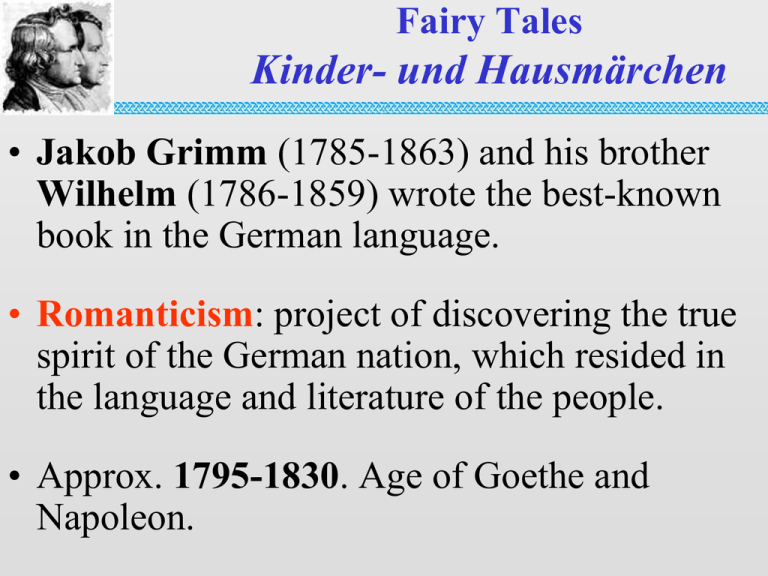
Fairy Tales
Kinder- und Hausmärchen
• Jakob Grimm (1785-1863) and his brother
Wilhelm (1786-1859) wrote the best-known
book in the German language.
• Romanticism: project of discovering the true
spirit of the German nation, which resided in
the language and literature of the people.
• Approx. 1795-1830. Age of Goethe and
Napoleon.
Kinder- und Hausmärchen
Who were the Grimm brothers?
• Their father is a respected court official, but dies
young, thrusting the family into poverty.
• Jacob and Wilhelm, the two oldest children, become
overachievers to provide for their family.
• Study of law in Marburg brings them to Friedrich
Karl von Savigny, professor of law.
• Savigny an important Romantic, believes in the
unification of Germany. Teaches the Grimms to
study German culture through the history of its laws.
Kinder- und Hausmärchen
Who were the Grimm brothers?
• Savigny introduces the Grimms to the older circle
of romantic poets in the area.
• 1806 Jacob decides to make a living as a scholar of
philology and literature instead of law.
• 1806-1807 a job in the War Commission until the
country is defeated by Napoleon.
• 1808 Jacob and later Wilhelm become Royal
Librarians in Kassel. First scholarly publications.
• 1812 publication of Kinder- und Hausmärchen.
Kinder- und Hausmärchen
Who were the Grimm brothers?
• 1829 they resign their positions in the library due to a
denied promotion and disgust with local politics.
• 1830 they both accept positions at the University of
Göttingen. Gifted and stimulating teachers.
• 1837 they and five colleagues protest the restoration of
absolutistic rule and are dismissed.
• Grimms blacklisted because of their liberal views.
• 1841 Savigny and Bettina von Arnim get them positions in
the University of Berlin.
• 1848 Grimms representatives in the National Assembly in
Frankfurt. Failed March Revolution in Germany.
Kinder- und Hausmärchen
Who were the Grimm brothers?
• Jacob retires from politics and teaching (but not
from research and writing).
• The brothers spend their final years working on a
complete historical dictionary of the modern
German language. They make it to the word
“Frucht” (fruit).
• The project is assumed by other scholars upon their
deaths – it is completed only in 1960, with teams
from both East and West Germany working in
collaboration.
Kinder- und Hausmärchen
Why did they collect folklore?
• In 1806, Achim von Arnim and Clemens Brentano
publish a collection of German folk songs, Des
Knaben Wunderhorn, which inspires the young
Grimm brothers.
• Through their mutual friend Savigny, the Grimms
are asked to collect tales for a third volume of The
Boy’s Wonder Horn.
• Grimms see the project as a scholarly contribution to
discovering and recording German cultural artifacts.
Early form of cultural anthropology.
Kinder- und Hausmärchen
Why did they collect folklore?
• Contrary to legend, they did not travel the
countryside in search of the tales.
• Most tales told to them by family friends, mostly
upper-middle-class women, some with a French
background.
• Wilhelm married one of their primary sources,
Dörtchen Wild. Wilhelm was the primary editor
for the later editions of this book.
• Two brothers collaborated on most of their projects,
always on extremely close terms with each other.
Kinder- und Hausmärchen
Why did they collect folklore?
• They send Brentano a copy of their tales, but he
neglects the text and later donates the manuscript to
a monastery (discovered only in the 20th century).
• When Volume III of Des Knaben Wunderhorn does
not materialize, the Grimms publish an edition of
tales with many scholarly footnotes (1812).
• Unexpectedly, the book is a popular success, and the
brothers prepare Vol. II (1815).
Kinder- und Hausmärchen
Why did they collect folklore?
• In their lifetime, Kinder- and Hausmärchen
(Children’s and Household Tales) sees seven
editions.
• After they realize the popularity of the book,
they delete the scholarly commentary and
sought to “improve” the tales for children: less
moral ambiguity in later editions.
• Their work inspired collections of fairy tales
in other national cultures in 19th century.
Kinder- und Hausmärchen
What else did the Grimm brothers do?
• In addition to fairy tales, the Grimm brothers
were the first scholars to do groundbreaking
research in a number of areas.
• In fact, they were two of the first professors of
German literature ever, and helped shape the
academic discipline as it is know today.
• Most of the topics discussed in this course –
Eddic poetry and Norse mythology, Germanic
languages, Germanic history and legends –
were first studied by the Grimm brothers!
Kinder- und Hausmärchen
What else did the Grimm brothers do?
• Grimm Brothers’ selected publications:
•
•
•
•
•
•
•
•
•
1813-1816 Collections of Essays on Germanic folklore
1815 Lays of the Elder Edda, edited volume
1816 German Legends
1819-37 German Grammar (Jacob)
1821 On German Runes (Wilhelm)
1829 The German Heroic Legend (Wilhelm)
1835-54 German Mythology (Jacob)
1848-53 History of the German Language (Jacob)
1852-1960 Historical Dictionary of the German Language
Kinder- und Hausmärchen
History of Fairy Tale Studies
Important Dates in Fairy Tale Studies:
1697 Charles Perrault's Histoires ou Contes du temps
passe, (Mother Goose Tales) is published.
1812 & 1814 Jacob and Wilhelm Grimm publish
volumes I and II of Kinder- und Hausmärchen
(Children’s and Household Tales).
1835 Hans Christian Andersen publishes Fairy Tales
Told for Children, some based on traditional
folklore, including ‘The Wild Swans’ and ‘The
Princess on the Pea.’
Kinder- und Hausmärchen
History of Fairy Tale Studies
1845 Norwegian Folk Tales, collected by Peter
Christen Asbjornsen and Jorgen Moe appears,
includes ‘East of the Sun and West of the
Moon’ and ‘The Three Billy Goats Gruff.’
1870-1910 The Golden Age of Illustration for
Childrens’ books – Walter Crane, Gustave
Dore, Arthur Rackham, Warwick Goble, et al.
1866 Aleksandr Afanasyev collects and publishes his
first volume of Russian fairy tales.
Kinder- und Hausmärchen
History of Fairy Tale Studies
1890 Peter Ilyich Tchaikovsky's ballet The Sleeping
Beauty premieres in St. Petersburg.
1893 Engelbert Humperdinck's opera, Hansel und Gretel
premieres.
1937 Walt Disney releases his first feature length
animated film, Snow White and the Seven Dwarfs.
1945 The premiere of Sergei Prokofiev's ballet,
Cinderella.
In the following decades, new print, television, and film
versions of fairy tales appear regularly.
Kinder- und Hausmärchen
What is a Fairy Tale?
• Grimm’s collection contains many kinds of
stories, including the magical (or wonder) tales,
humorous tall tales, animal fables, and realistic
folk tales.
• Originally oral folk tales, with countless variants
throughout Europe.
• There are no “original” versions of tales, only
earlier and later variants of tales.
• Social context of tales changed when they were
transformed into written literature.
Kinder- und Hausmärchen
What is a Fairy Tale?
• Short stories in prose, originally for adults, but
commonly for children nowadays (a development
begun at the time of the Brothers Grimm).
• A peasant perspective, quite unlike the aristocratic
perspective in heroic legends or middle-class
perspective of early modern legends.
• Unlike legends, which deal with ostensibly historical
events, fairy tales are set in a vaguely medieval,
indeterminate time and place.
• Plots and images common in different lands.
Kinder- und Hausmärchen
What is a Fairy Tale?
• Fairy tales typically have no character development
– strong contrasts between ‘good’ and ‘bad’
characters are typical.
• Use of magic and magical items is common.
• Familial setting is typical, often dysfunctional or
incomplete nuclear family setting. Many tales
present a child’s perspective of the action.
• Family tensions tend to play important roles.
• Strong reliance on stock characters and very wellknown motifs and plot structures.
Kinder- und Hausmärchen
What is a Fairy Tale?
A few common fairy tale motifs:
• Triumph of the youngest, laziest, dumbest, weakest, most
oppressed, least promising, etc.
• Triadic structure, circuitous journey with reversal of fortune
• (Familial) adversaries – establishment of improved and
secure familial structure at end
• Helping figures, with magical objects and creatures
• Rewards in the form of honor, wealth, spouse, power
• Talking animals – animate world, with enchanted cosmos
• Happy end, poetic justice, reward and retribution
Kinder- und Hausmärchen
What is a Fairy Tale?
• What are fairy tales not?
• Morally unambiguous tales a product of the modern
concern for proper child-rearing.
• “Original” versions of many fairy tales contain a lot
of sex and violence.
• Protagonists can be active or passive, male or
female, successful or unsuccessful.
• Tales may be innocent or cynical in tone.
• Difficult to generalize about fairy tales…
Kinder- und Hausmärchen
How does one interpret fairy tales?
• A Historical Approach to fairy tale research is
very complicated.
• “Origins” of fairy tales extremely difficult to
trace, since motifs are common in Europe and
even beyond – Cinderella stories are found
everywhere.
• Unlike many legends, there is absolutely no
factual historical basis for folk tales. Actually,
there are no truly realistic plots in any of the
tales.
Kinder- und Hausmärchen
How does one interpret fairy tales?
• A Psychological Approach
Bruno Bettelheim argues that fairy tales present an
internal psychological truth: “In a fairy tale, internal
processes are externalized and become
comprehensible as represented by the figures of the
story and its events.”
• Some Common Topics: Power and class relations,
Freudian sexual fantasies, Jungian archetypes,
cultural images, Christian and pagan ideologies and
rites, collective class consciousness, etc.
Kinder- und Hausmärchen
How does one interpret fairy tales?
• A Cultural Approach
• Robert Darnton argues that “Folktales are historical
documents, each colored by the mental life and
culture of its epoch.”
• Different variants of tales in one country or in
different countries point to regional or cultural
differences.
• Details in fairy tales are often very arbitrary,
depending on the interests of a particular audience.
Kinder- und Hausmärchen
How does one study Fairy Tales?
• A Comparatist Approach
• 1961 Stith Thompson expands and translates
Finnish scholar Antti Aarne's The Types of the
Folktale (1910) into English in 1961.
• The Aarne-Thompson Classification System
becomes the most widely used for classifying
Indo-European folktales, cataloging some 2,500
basic plots and over 10,000 motifs.
• There are dozens or hundreds of variants for all
of the Grimm fairy tales.
Kinder- und Hausmärchen
How does one study Fairy Tales?
• A Structuralist Approach
• Vladimir Propp (1928) publishes Morphology of
the Folktale (English translation 1958). He
emphasizes the recurring structural features of
folk and fairy tales.
• Both the Aarne-Thompson classification system
and Propp’s structural models are considered
essential tools for the current study of folk tales.
• Oral folk literature is difficult to interpret; a
flexible, holistic method is probably best.
Kinder- und Hausmärchen
How does one study Fairy Tales?
• Fairy Tale structure as Wish Fulfillment
• Frame with circuitous journey.
• Dysfunctional family in opening frame. Suffering,
helplessness and victimization of protagonist.
• Adventures and tests in supernatural realm
• Reversal of fortune, reward of marriage or power
• Vengeance or punishment of villains – suffering
projected onto the former oppressors.
• Nearly everyone capable of cruelty and vengeance.
Kinder- und Hausmärchen
Fairy Tales and Wish Fulfillment
• “The Fisherman and his Wife” is a good example
of wish fulfillment.
• A fisherman catches a talking flounder that is
really an enchanted prince, so he lets him go.
• His wife, however, makes repeated requests from
the fish, since he now has an obligation to the
family: cottage, castle, king, emperor, pope, God.
• Enchanted flounder grants all their wishes, which
eventually bring them back to the hovel in which
they began. Be careful what you wish for!
Kinder- und Hausmärchen
What makes the Grimm tales unique?
• Lukewarm reviews of the first edition led Wilhelm
to edit the tales, with increasing changes in final
editions. Further removed from peasant origins.
• Transmission of tales often involves censorship or
bowdlerization.
• Violent subject matter was actually increased in
many fairy tales (unlike U.S. versions!).
• “Certain conditions and relationships” were deleted
as inappropriate material for children:
Premarital sex
incest
pregnancy
Kinder- und Hausmärchen
Censorship and Fairy Tales
Disney’s Tangled
(2011).
Good example of
editing and
revising of a fairy
tale for new
audiences.
Disney interpretation of Rapunzel as repressed
adolescent desire. Girl empowerment.
Rapunzel
AT 310 The Maiden in the Tower (Rapunzel)
Husband and wife have been wishing for a child for
years, finally the wife gets pregnant.
They live in a house which borders a beautiful garden
that belongs to a sorceress.
One day the wife stands at the window and beholds some
rapunzel-lettuce that grows there and develops a craving
for it.
Craving the rapunzel-lettuce, the wife falls ill with grief,
so that the husband has to enter the garden to steal some
of it.
Once the wife has tasted the lettuce, her craving
increases, so the husband has to climb the wall once
more.
Rapunzel
This time, the sorceress catches him. He explains his
wife´s condition; the sorceress allows him to take as
much lettuce as he wants – if she can have the child!
In fear, the man complies.
The child grows up to be a beautiful girl, named
Rapunzel
Rapunzel is taken way to a tower in the forest when she
is twelve years old (cite 43).
A few years later, a young prince happens by and
watches the sorceress climbing the tower with the help of
Rapunzel´s hair.
At night, he calls “Rapunzel, Rapunzel, let down your
hair for me!”
Rapunzel
Rapunzel
Rapunzel is shocked to find the first man she´d ever laid
eyes on in her bedroom at night!!!
The prince proposes to her and she sighs, “Yes!”
They make a plan to rescue Rapunzel: The prince will
bring a skein of silk and she will weave it into a ladder,
then they would ride away.
But Rapunzel blurts out the secret, and the sorceress
(mother Gothel) takes the girl away to a far off land.
She lays an ambush for the prince and tells him that he
will never see Rapunzel again (cite 45).
Prince jumps off the tower in despair, is blinded by
landing in thorns, lives in misery for years.
Rapunzel
Happy ending: On his ramblings, he meets Rapunzel by
chance. As she weeps for joy, her tears fall into the
prince´s eyes and his eyesight returns.
They return to the prince´s kingdom and live happily
ever after. They pass their “test” and are rewarded.
The Grimms added the marriage proposal to the original
version, which dealt (obviously) with premarital sex.
In the manuscript version, it is her pregnancy that gives
her away to the sorceress.
The twins are retained, but the context has been changed
to obscure the parents’ indelicate behaviour.
Kinder- und Hausmärchen
Animal Bridegrooms
• The Frog King, or Iron Heinrich (2-5)
• AT 440 The Frog Prince
• A good example of differences in versions of a fairy
tale!
• English version, the
princess kisses the frog
who turns into a prince,
and they live happily
ever after…
Kinder- und Hausmärchen
Animal Bridegrooms
• The German version presents more violence!
• The Frog fetches her golden ball in return for
her affection.
• The Frog wants more from the princess than
just a kiss (2).
• The Frog follows the princess everywhere,
even into her bed! (Freudian projection?!)
• The girl is afraid of the Frog, so she dashes him
against the wall (3).
Kinder- und Hausmärchen
Animal Bridegrooms
Kinder- und Hausmärchen
Animal Bridegrooms
Kinder- und Hausmärchen
Animal Bridegrooms
• “When he fell to the ground, he was no longer a frog
but a prince with kind and beautiful eyes…” (3).
• Her father gives his blessing, they become “dear
companions” and get married.
• In the manuscript version: The frog “falls down into
her bed and lies there as a handsome young prince,
and the king’s daughter lies down next to him.”
• Wilhelm Grimm inserted the chaste scene with the
father and the marriage, erased the sexual content.
Kinder- und Hausmärchen
Animal Bridegrooms
• “Beauty and the Beast”
• “The Singing Springing Lark”
• Adolescent heroines perceive their bridegrooms to
be bestial and dangerous – monsters, wild animals –
but succeed in rescuing or transforming them into
attractive men. Domestication fantasy?
• Psychological reading of the text emphasizes the
transformation in the girl’s perception of masculinity
rather than the physical transformation of the beast.
• Adolescent anxiety with maturity and sexuality.
Kinder- und Hausmärchen
Prohibition, Transgression, Punishment
• In “Bluebeard” (or variant “Fitcher’s Bird”), the
bridegroom is a monster in human form.
• The bride is given a key (or egg) for safekeeping,
but her curiosity leads her to open a forbidden door
and discover a monstrous secret.
• Key/egg falls into blood; the stain is a mark of guilt.
• The forbidden chamber may represent “carnal
knowledge” – the blood-stained key hints perhaps at
loss of virginity or at marital infidelity.
Kinder- und Hausmärchen
Prohibition, Transgression, Punishment
• Oddly, narrators (and later editors) condemn
curiosity more than serial murder!
• Stories seem to deal with adolescent fear of adults’
secrets, of maturity, marriage, and sexuality.
• In both “Bluebeard” and “Fitcher’s Fowl,” the
heroine defeats the would-be bridegroom and
returns to her family and to her brothers.
• In effect, she returns to her childhood existence and
no longer has to worry about confronting the horrors
of marriage or sexuality.
Kinder- und Hausmärchen
Review of Interpretative Difficulties
• Interpretation of fairy tales is complicated:
1. Many different versions of fairy tales.
2. No one “original” authoritative text.
3. Details of versions are especially arbitrary.
4. Supernatural events invite interpretation.
5. “Simple” tales encourage allegorical readings.
6. Many interpretations tell us more about the
anxieties of the interpreter!
Fairy Tales
Little Red Cap 101-105.
• Tame American version is well known.
• In a French version, the heroine unwittingly
consumes the flesh and blood of her
grandmother, is called a slut by her cat, and
performs a slow striptease for the wolf.
• In an Italian version, the wolf kills the mother,
makes a latch cord of her tendons, a meat pie
of her flesh, and wine from her blood.
Fairy Tales
Little Red Cap 101-105.
• The German Version is slightly different:
• Cake and Wine for grandmother.
• Wicked Wolf tempts the “juicy morsel’ with
flowers and birds to distract her.
• Wolf gobbles up the grandmother.
• Big ears, big hands, terribly big mouth…
• Wolf gobbles up Little Red Cap and snores.
• A huntsman happens by, hears odd snoring…
Fairy Tales
Little Red Cap
Fairy Tales
Little Red Cap
Fairy Tales
Little Red Cap
• The Huntsman wants to
shoot the sleeping wolf, but
fears harming Grandmother.
• He cuts open the belly, and
out jump Little Red Cap and
Grandmother.
• They fill his belly with large
stones – he leaps up and
falls down dead.
Fairy Tales
Little Red Cap
•
•
•
•
Wilhelm Grimm added a short epilogue:
Huntsman gets the fur of the wolf.
Grandmother gets the cake and wine.
Little Red Cap gets an admonition never to
stray from the path her mother has given her.
• This nice little fairy tale has led to some
surprising interpretations….
• Some actual interpretations:
Fairy Tales
Little Red Cap
• Tale records contact with actual werewolves.
• Little Red Cap represents the burning sun setting
forth on her westward journey home.
• Wolf represents male pregnancy envy, killed
ironically by stones, symbols of his sterility.
• Wolf is a projection of Little Red Cap’s pubertal
sexual desire.
• A parable of rape and female helplessness.
• Usual reading: One should not trust wolves.
Kinder- und Hausmärchen
Gender Roles in Fairy Tales
• Strictly defined gender roles created by the Brothers
Grimm (originally more variation).
• Boys use luck (and and sometimes) wits to achieve
power and wealth. Hard work never makes boys
wealthy or successful!
• Girls use obedience and willingness to work to
achieve a proper marriage.
• All girls are beautiful – but industry and obedience
make them desirable (e.g. Rumpelstiltskin).
Kinder- und Hausmärchen
Gender roles
• “Mother Holle” (88-91) a good example of the tale
of the kind and unkind daughters.
• The kind daughter willingly undertakes demeaning
and difficult tasks, and reaps a great reward. She
demonstrates the prime female virtues of humility,
obedience, and diligence.
• The unkind daughter refuses to demean or debase
herself, does not learn humility, and is punished for
her disobedience.
Kinder- und Hausmärchen
Patriarchal Control
• “King Thrushbeard” (177-180) is also a good
example of gender roles as emphasized by the
Grimms’ patriarchal perspective.
• The princess does not want to obey her father, so he
marries her to the first beggar to appear.
• The “beggar” humiliates her several times to teach
her the value of humility and obedience.
• Once she learns “her place,” she is rewarded with a
marriage to her true husband, the King.
Kinder- und Hausmärchen
Male Heroes
• Active male heroes are actually very rare.
• More typical are the young, naïve, stupid boys who
lack common sense.
• Peasant perspective is clear in that not a single male
hero ever succeeds through hard work or study.
• Compassion and humility make hero “good,” allow
for his eventual reward.
• Helper figures perform all tasks that require any
specific skill or ability, though the hero seems to
acquire these skills by association.
Kinder- und Hausmärchen
Male Heroes
• The boy “who went forth to learn fear” is a typical
naïve hero: he is too inexperienced to behave
rationally. His “bravery” is indistinguishable from
foolhardiness.
• Wagner used this figure in his characterization of
Siegfried in his Ring Cycle opera.
• He succeeds in situations where his lack of sense is
an advantage – though in reversing his fate, he
seems to have reversed his character traits as well.
Kinder- und Hausmärchen
Male Heroes
• “The Devil with the Three Golden Hairs” and
“Puss-in-Boots” also present tales with clever
(rather than hard-working) male protagonists.
• Both tales have important helper figures who have
the qualities needed to aid the hero and provide him
with the objects he will need.
• In acquiring outside aid and objects, the hero
symbolically acquires these qualities as well.
• Tales end with reversal of fortune, providing the
hero with wealth, position, power, and a spouse.
Kinder- und Hausmärchen
Parental Desire for the Child
• Dysfunctional families and patterns of abuse
are a common beginning point in fairy tales.
• The theme of incest is not uncommon in the
manuscript versions of some of the tales.
• Jacob and Wilhelm sought to erase images of
parental misbehavior, or to refocus such desires
in ways that were more socially acceptable.
• “All Furs” (“Thousandfurs”) and “The Maiden
Without Hands” both dealt in early versions
with a father’s desire for his daughter.
Kinder- und Hausmärchen
The Maiden Without Hands 118-123
• This story is not well known in the U.S.
• A miller falls into poverty, and is tricked by the
devil into trading his daughter for wealth.
• The sinless girl is too clean for the devil.
• The father chops off her hands so that the devil can
take her – she obediently complies.
• The girl takes her hands and leaves home.
• An angel guides her to a garden, she eats forbidden
pears.
Kinder- und Hausmärchen
The Maiden Without Hands
• The King notices a missing pear, decides to
discover the reason.
• The King gives her silver hands, marries her.
• She gives birth – but the devil tries to get the King’s
mother to kill her and the child.
• King’s Mother kills a deer instead.
• She leaves with her child, lives in the forest.
• King learns of devil’s deception, searches far and
wide for the girl.
Kinder- und Hausmärchen
The Maiden Without Hands
• After 7 years, the King finds his wife and child;
they are reunited and return home to live happily
ever after…
• Different versions collected by Grimms.
• The Devil is inserted in the introduction; in the
manuscript version, the Father wanted to marry the
daughter.
• Her refusal led him to cut off her hands and her
breasts. That is why she did not want to stay with
him, despite all his money…
Kinder- und Hausmärchen
The Maiden Without Hands
• Wilhelm Grimm was able to erase the theme of
incest by reintroducing the devil.
• Incest also appears in other tales, such as “All
Furs,” in which the daughter runs away from home
to avoid a father who wants to marry her.
• Much more common are fairy tales with strong
suggestions of Oedipal and Electra complexes – the
child desires the parent of the opposite sex.
• Grimms also actively erased such desire where it
was obvious in the text.
Kinder- und Hausmärchen
Freudian Electra Complex
• Electra Complex places a
girl in competition with her
mother for her father’s love.
• Most Stepmothers in tales
were originally mothers!
(Wilhelm changed that).
• Note change of perspective
in the audience; focus
changes from adult to child.
Evil Stepmother / Witch / Mother-in-law
Kinder- und Hausmärchen
Hansel and Gretel
• Originally, the mother wanted to leave the
children in the forest.
• The Mother in “Mother Holle” also transformed
into a wicked stepmother with a step-child.
• Child abuse, abandonment and infanticide are
often seen as Freudian projections of childhood
resentment as parental malice.
• That is, a child’s “I hate you” is refashioned here
as “you hate me.”
Kinder- und Hausmärchen
Hansel and Gretel
•
•
•
•
•
The supernatural realm contains heightened
versions of the problems faced at home.
The witch of the forest figures as the wicked
stepmother without her disguise.
By overcoming the obstacles in the magic forest,
they solve their true problems at home.
Death of the witch coincides with the
disappearance of their mother at home.
“Brother and Sister” has similar conflict with a
wicked stepmother/witch.
Kinder- und Hausmärchen
Snow White
• Snow White
• Disney (1937) first
full-length feature
film.
• The villainess was
originally her own
mother – not a
wicked stepmother.
• Good example of
Electra complex.
Kinder- und Hausmärchen
Snow White
• Many folklorists see the voice in the mirror as the
father figure – when he decides the daughter is
more attractive than his wife, she is forced to
eliminate the competition.
• In the manuscript version, Snow White only had
to “keep house,” but Wilhelm exaggerated her
work ethic by adding quite a few chores! (183f.)
• The evil queen is punished at the wedding by
being forced to wear glowing iron slippers and
dancing until she falls down dead.
Kinder- und Hausmärchen
Snow White
• Some recent film versions of Snow White!
Kinder- und Hausmärchen
Freudian Family Romance
• According to one psychological interpretation, the
mother is split into two different images, a good,
absent mother, and an evil stepmother.
• Generally dysfunctional families of fairy tales often
reflect Freudian “Family Romance.”
• Children imagine themselves misplaced in the
wrong family – their true home is much nicer,
wealthier, more respected…
• Orphan and foundling tales reflect such wishes.
Family Romances
Goose Girl and Bremen Town Musicians
• Both of these tales describe the attempts of the
protagonists to find their true home.
• The “Goose Girl” is a princess whose servant has
stolen her position and relegated her to a life of
poverty and labor. She is eventually recognized and
restored to her true position – while her adversary is
killed brutally as punishment.
• The “Bremen Town Musicians” – rooster, cat, dog,
donkey – have been evicted from their previous
homes and have to find a new one. “Why die when
you can find a better life somewhere else? “
Kinder- und Hausmärchen
The Juniper Tree 171-179.
• Some fairy tales do not fall into any neat categories,
such as ‘The Juniper Tree’:
• This tale contains a dysfunctional family, an evil
stepmother, child abuse, infanticide, cannibalism,
transformations, magical animals, and murder.
• The good mother gives birth to a boy, then dies.
• She is buried beneath the Juniper tree.
• Next wife has a good daughter, but she mistreats the
boy and favors her own girl.
Kinder- und Hausmärchen
The Juniper Tree
• The mother kills the boy, blames the girl, cooks him
in a stew that only the father eats. Delicious!
• The girl takes her brother’s bones to the Juniper
Tree, which transforms them into a talking bird.
• The singing bird gets a golden chain, a pair of shoes,
and a heavy millstone.
• Father hears the bird, gets the golden chain.
• Marlene hears the bird, gets the red shoes.
• And the evil mother…
Fairy Tales
The Juniper Tree
Kinder- und Hausmärchen
The Juniper Tree
• Mother hears the bird, gets the millstone on her
head!
• The little boy returns to his usual shape.
• Despite his wife’s death, the father is now “very
happy,” and the three of them go back inside, sit
down at the table, and eat.
• This tale was the one that inspired Brentano and
von Arnim to start looking for tales!
• If you have a good interpretation of this fairy tale,
I would love to hear it!
Kinder- und Hausmärchen
Folk Tales
• Unlike fairy tales, which are conservative and tend
to uphold a strong patriarchal sense of order and
propriety, Folk Tales reflect a peasant perspective
that relishes inversions of the social order.
• Folk tale heroes come from most downtrodden
social levels, peasants, retired soldiers, tailors, etc.
• Folk tales tend to be more satirical and more
“realistic” than the supernatural fairy tales.
• Folk tales more often offer adult perspectives rather
than a child’s point of view.
Kinder- und Hausmärchen
Folk Tales
• “The Blue Light” describes the life of a retired
soldier – he is old and useless, so the King has sent
him away with nothing. He is at the bottom of the
social order, has neither money nor property.
• A witch exploits his labor, but he gains a magical
blue light that summons a little black dwarf (like a
genie in a bottle).
• The dwarf aids him in getting his revenge,
eventually gaining the kingdom and the king’s
daughter. Folk heroes are ruthless to competitors.
Kinder- und Hausmärchen
Folk Tales
• “Dr. Know-It-All” is a good example of a folk tale
in which a poor (though foolish) man uses his wits
(and his luck!) to improve his station in life.
• Medical profession mocked from a peasant
perspective –to be a doctor one needs only a picture
book, some nice clothes, and a sign!
• “Little Farmer” is similar. A foolish farmer uses a
wooden calf as the foundation of his rise to power,
eventually eliminating all competition and gaining
all the wealth in the local village. Ruthlessness.
Kinder- und Hausmärchen
Folk Tale Heroines
• While fairy tale heroines demonstrate their virtue
through a strong work ethic (Cinderella, Mother
Holle, Snow White), folk tale heroines try to avoid
work!
• The girl in “Rumpelstilzkin” cannot spin straw into
gold, and does not ever try – she succeeds in
avoiding work through the intercession of the evil
little man.
• Another example of work avoidance is the tale “The
Three Spinners.”
Kinder- und Hausmärchen
The Three Spinners
• A lazy girl refuses to do any spinning, so her mother
beats her.
• Queen hears her cries; her mother lies, telling her
that her daughter won’t stop spinning!
• Queen takes the girl home, and she promises the
“industrious” girl her son in marriage if she spins all
the flax.
• Girl sits and cries – typical response for heroines in
tales by the brothers Grimm.
Kinder- und Hausmärchen
The Three Spinners
• Girl begs three odd looking women for help – one
had a flat foot, one a protruding lower lip, one an
enormous thumb.
• They offer to help, if she invites them to her
wedding, is not ashamed of them, calls them
cousins, and eats with them. (Having a good heart is
more important that being hard-working).
• They spin the flax to yarn in no time.
• The prince is delighted to get such a skillful and
industrious girl as his wife…
Kinder- und Hausmärchen
The Three Spinners
• The wedding comes, and the girl is careful to invite
the three old women.
• The prince finds them ghastly – asks how they came
to be so disfigured:
• From treading, from licking, from twisting…
• Prince swears that his beautiful wife will never be
allowed to spin flax any more!
• Triumph of the laziest girl!
• Realistic setting, reversal of usual order.

